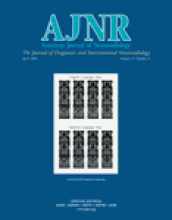Abstract
BACKGROUND AND PURPOSE: Patients with traumatic brain injury (TBI) and low Glasgow coma scale (GCS) scores may have severe injury associated with cellular disruption that can be studied with whole-brain apparent diffusion coefficient (ADC) histograms. We retrospectively studied this hypothesis and correlated ADC with GCS.
METHODS: Twenty-one patients (37.81 ± 41.3 years) with TBI were enrolled: Group A had normal MR imaging findings but low GCS scores (n = 6). Group B had brain stem injury with low GCS scores (n = 6). Group C had cortical lesions with normal GCS scores (n = 5), and group D had cortical lesions with low GCS scores (n = 4). Eleven control subjects were enrolled (32.7 ± 19.2 years). Whole-brain ADC maps and histograms were generated and normalized for each subject. Mean and peak ADCs were determined. A one-sided t test was performed for each parameter. Average GCS scores and corresponding peak and mean ADCs were correlated.
RESULTS: Peak histogram values significantly differed between controls and groups A, B, and D (P < .0019, P < .00129, and P < .0148, respectively). In groups A and D, values were significantly skewed compared with control values. Mean ADC was significantly different between the control ADC and group A (P < .013) but not group C. In each group, peak ADC and GCS score were strongly correlated (R2 = 0.67).
CONCLUSION: Whole-brain peak ADCs and GCS scores are significantly correlated in patients with TBI. Although conventional MR images were normal, ADC independently indicated TBI and better represents the degree of neurologic dysfunction.
- Copyright © American Society of Neuroradiology












